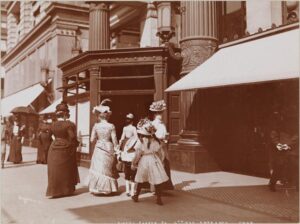Let’s turn back the clock to 19th century New York City and take a walk on “Ladies’ Mile.” The streets bustle with potential shoppers ready to spend the day exploring the wares of the stores, or enjoying a leisurely lunch with friends. You might run into Mrs. Mary Todd Lincoln, Edith Wharton, Mark Twain, Upton Sinclair, Henry James, Mrs. Grover Cleveland or even a young Bernard Baruch.
(Museum of the City of New York)
(Museum of the City of New York)
The first commercial establishments to move “uptown” were small retail shops which relocated to the first or second story of rowhouses as early as the 1830s.

(Museum of the City of New York)
By the 1850s Broadway became the most exclusive shopping area in the city, and architects were employed to build large “commercial Palaces” which were the vogue at the time. Broadway was the location of large dry goods stores, retail stores selling household furnishings and small specialty stores. Sixth Avenue became a major destination for shoppers after the Civil War, and with the opening of the Sixth Avenue El in 1878 prospective shoppers descended on the area from all parts of the city. 23rd Street, the Northern boundary of Ladies’ Mile, was developed for retail trade at the same time as Sixth Avenue, and major department stores opened there, joined by specialty stores offering furniture, china and toys. Even the side streets redefined themselves and the old rowhouses were often altered for commercial use.

(Museum of the City of New York)

